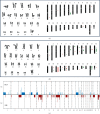Cytogenomic Abnormalities in 19 Cases of Salivary Gland Tumors of Parotid Gland Origin
- PMID: 33343950
- PMCID: PMC7725583
- DOI: 10.1155/2020/8897541
Cytogenomic Abnormalities in 19 Cases of Salivary Gland Tumors of Parotid Gland Origin
Abstract
Salivary gland tumors (SGTs) of parotid origin are a group of diverse neoplasms which are difficult to classify due to their rarity and similar morphologic patterns. Chromosome analysis can detect clonal abnormalities, and array comparative genomic hybridization (aCGH) analysis can define copy number alterations (CNAs) from tumor specimens. Of the 19 cases of various types of SGTs submitted for cytogenomic analyses, an abnormal clone was detected in nine cases (47%), and CNAs were detected in 14 cases (74%). Recurrent rearrangements involving the PLAG1 gene at 8q12, recurrent CNAs including deletions of 6q, 9p (CDKN2A), and 17p (TP53), loss of Y chromosome, and gain of chromosome 7 were defined from these cases. Combined karyotyping and aCGH analyses could improve diagnostic yield. Future study for more precisive correlation of SGT classification with cytogenomic abnormalities will facilitate better diagnosis and treatment.
Copyright © 2020 Marie Zerjav et al.
Conflict of interest statement
The authors declare that there are no conflicts of interest regarding the publication of this paper.
Figures

References
-
- Rousseau A., Badoual C. Head and neck: salivary gland tumors: an overview. Salivary Gland Tumors. 2010;10
Publication types
LinkOut - more resources
Full Text Sources
Research Materials
Miscellaneous

